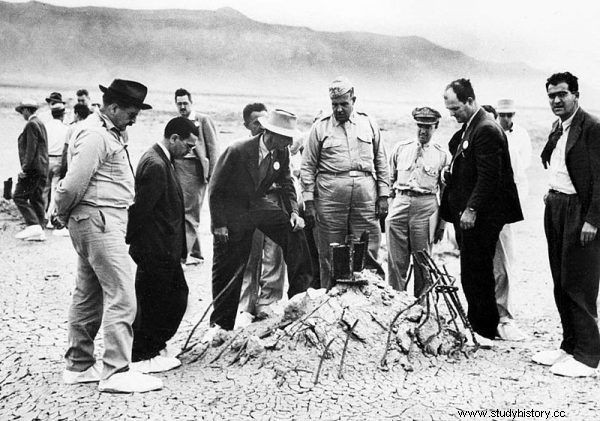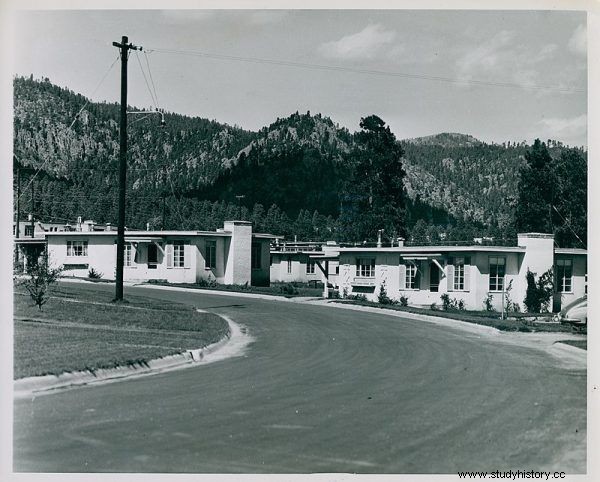On July 16, 1945, a powerful flash illuminated the desert near Alamogordo, New Mexico. 300 kilometers from the site of the explosion, windows shook in buildings. The explosion was a force of 21,000 tons of TNT. Seeing this, Robert Oppenheimer stated, "Now I have become death, the destroyer of worlds."
On that summer day, when the world's first atomic bomb exploded, the scientist was quoting words from the Hindu scriptures of the Bhagavad Gita. They fit the occasion as he found. The same bomb called "Fat Man", containing an enriched plutonium charge, wiped the Japanese city of Nagasaki off the face of the earth less than a month later. Three days earlier, a load of "Little Boy" fell on Hiroshima. About 30 percent of the population - 70,000-90,000 people lost their lives in a matter of minutes.
The American power was at that time the only owner of the most dangerous weapon in history. It was also the personal success of a group of scientists working under a government program known as the Manhattan Project. Its manager, Robert Oppenheimer, was baptized by the press as "the father of the atomic bomb". Who was this man whose invention changed the world forever?
Bomb communist
Oppenheimer was born into an American Jewish family. From an early age he showed a fascination with science. Instead of hanging around with his friends, he pored over books. He quickly gained a reputation as a gifted introvert. At Harvard University, he studied not only physics, but also Greek architecture, art and literature. He learned ancient languages on his own.
The turning point in his career was his departure to Europe. Here he met the fathers of modern physics:Niels Bohr, Werner Heisenberg, Enrico Fermi and Paul Dirac, among others. At the age of only 22, he became a doctor. After returning to the United States, quickly achieved the status of one of the US's most respected physicists . When, in the early 1940s, in response to the Third Reich's nuclear program, the US military was looking for a scientific director for its own research, General Leslie Groves, who was overseeing the case, selected Oppenheimer.

Robert Oppenheimer (in a pale hat, center) and his colleagues at the site of the world's first atomic bomb detonation in the New Mexico desert.
However, there was a problem. The scientist was "x-rayed" by the FBI, and it was then revealed that the genius of physics was politically "behind the ears". For years, he sympathized with the communists. He even donated money to those fighting in the Spanish Civil War. As reported by Robert Jungk:
When Oppenheimer became the owner of a large fortune in 1937 after the death of his father, he began to regularly support the left-wing movement with large sums. From time to time, he wrote anonymous pamphlets of several pages on current events, printed them at his own expense, and sent them out through an anti-fascist intellectual organization under the influence of communists.
Years later, Oppenheimer claimed that he was pushed to the left by the great American crisis of the early 1930s, but in fact Jean Tatlock, a voluptuous doctor of psychiatry and a member of the American Communist Party, had a lot to do with it. They began romancing in 1936. Back then, Tatlock was still a student at Stanford and Oppenheimer a professor at Berkeley. Their passionate sexual and political relationship flourished even when the eminent physicist married Kitty Harisson (also a communist) in 1940.
He met Tatlock several times on the side, including while he was building the atomic bomb. Meanwhile, their illegal amours were being followed by the FBI. Was Oppenheimer's mistress a Soviet spy? Some people still ask themselves this question - especially since Tatlock died mysteriously in 1944. She drowned in the bathtub in her apartment. Severe depression was officially recognized as the cause of suicide.

The FBI distrusted the genius of leftist physics for a long time and delayed issuing him a safety certificate. General Groves had to intervene in person. Eventually, however, Oppenheimer became head of the most important military-scientific project of the 20th century.
"None of my interviewees showed any greater enthusiasm about Oppenheimer as a potential director" Groves later recalled, but it turned out that his choice was right. "Oppi" proved to be an excellent scientist and organizer.
Atomic Town
Research on the new weapons took place near the small town of Los Alamos in the mountainous, desert region of New Mexico. A militarized settlement for 4,000 civilians and 2,000 military was established there. In Los Alamos, officers and scientists lived side by side, and everything was supervised by the special services. Rodrick Braithwaite in Armageddon and Paranoia. Cold War - Nuclear Confrontation ”describes:
The area has been secured and fenced. Entry and exit was controlled by the military police. There were no banks or a post office inside Los Alamos. Correspondence was censored. Cameras were confiscated. (...) The women were not supposed to know what their husbands were doing - of course it was an impossible prohibition .

Los Alamos seemed to be just another ordinary American town. However, it was created for one purpose - to create a weapon that would change the fate of the world.
There were also those who made fun of security measures. Richard Feynman, one of the biggest "brains" on the team, had a habit of mocking the "Orwellian" protection systems in the nuclear town. As reported by Braithwaite:
He learned how to break into official safes and left provocative notes inside them. When the censors asked him to notify his young wife Arline, who was still living in New York at the time, not to mention anything about censorship in her letters, he pointed out to them that he was unable to do so because he was forbidden to use the word in his correspondence .
The Oppenheimer quickly gained recognition from the crew. For days he drove the military jeep between the posts. He sat in the corner and watched the work with his inseparable cigarette in his mouth (he smoked up to 6 packets a day). He discussed, inspired and was extremely effective at the same time. Soon - also thanks to him - the greatest US physicists could test their invention:a weapon capable of bringing destruction to millions of people ...
"God personally appeared among us"
The project, code-named Trinity, was prepared in a hurry so that President Harry Truman at the Potsdam conference could show off his new weapon to Stalin. The prototype of the plutonium bomb "Fat Man" was hung from a 30-meter steel tower in the desert, just over 9 kilometers from the checkpoint where scientists and military were stationed. On July 16, 1945, at 5:21 am, an atomic bomb exploded for the first time in human history.
The people in the shelters saw the light first, which they later referred to as penetrating, then there was a mighty roar. Oppenheimer began to quote Hindu holy books. Chemist Georg Kistiakowsky literally fell to the ground at the time of the explosion. "It was as if God personally appeared among us," he recalled years later.

The first successful nuclear weapons test was carried out in July 1945 by the Americans (in the photo, soldiers are carrying some equipment in preparation for Operation Trinity, the Jumbo container was ultimately not used during the test).
Some stared in utter silence at the mushroom cloud rising 12 kilometers high. There were also those who were already aware of the consequences of what happened. "Now we're all motherfuckers," said Ken Bainbridge, an experimental physicist at Harvard University, such a successful nuclear weapons test.
You could feel warmth on your face within 30 kilometers from the event. More than 300 kilometers away, glass shook in the windows of the buildings. The "Fat Man" prototype left a crater 300 meters in diameter and 3 deep. Nothing was left of the steel structure on which the bomb was hung. Robert Jungk recalls:
Although many of the population living near the test site and within a radius of about 200 kilometers saw an unusually bright glare in the sky at 5.30 am, were reassured by a message issued by Moynahan , head of the press "Manhattan Project" that "an ammunition warehouse exploded near Alamogordo ; there were no human victims " .
The game is beyond the champ
Scientists were still living in Los Alamos when Little Boy brought Hiroshima death. A few days later, "Fat Man" fell on Nagasaki. In the heat of the war, no one asked about moral questions. The newspapers made superhero physicists.
Oppenheimer, however, distanced himself more and more from his work. Complained that the charge was used against an enemy who was doomed to fail anyway . Apparently, during a meeting with Harry Truman, he said, "Mr. President, I have blood on my hands." The US leader was to be irritated by the scientist's "teary tone".

Scientists realized that the Hiroshima genocide was just a "foretaste" of what could happen to mankind when a much stronger charge was produced - the hydrogen bomb. Oppenheimer was a staunch opponent of developing such a weapon. His opinions, however, were ignored. The head of the project was a former subordinate of Oppenheimer - Edward Teller. Interestingly, Teller's team also included a Polish scientist - Stanisław Ulam from Lviv.
In 1952, the world "got" a hydrogen bomb. The first explosion - in Enewetak Atoll - had a force of 10.4 MT (equivalent to the strength of about 700 nuclear bombs dropped on Hiroshima). It was not, however, the strongest explosion - this infamous title belongs to the Soviet "Car-bomb" with a strength of about 58 megatons . What's more, its design allowed the use of a 150 megatons charge, but it was abandoned for fear of unforeseen consequences ...
And the one who opened this apocalyptic Pandora's box? In the 1950s, Oppenheimer lost his position as the idol of the Americans and became a suspect of espionage for the USSR. The FBI became interested in him again. So from then on, the physicist lived a life of wiretapping, dragged from one interrogation to the next.
Ultimately, despite the fact that nothing was proven to him, "Oppi" was marginalized. His safety certificate has been withdrawn. The once "destroyer of worlds" had to settle for a modest position at a private research facility at Princeton. He died of laryngeal cancer in 1967. For this work of his life - albeit deadly - will remain immortal.
Bibliography:
- Adamczyk A., Castle Bravo - a very unlucky explosion , www.kwantowo.pl (access:2019-06-16).
- Bird K .. Sherwin M.J., American Prometheus:The Triumph and Tragedy of Robert Oppenheimer, "Twój Styl" Publishing House 2007.
- Braithwaite R., Armageddon and paranoia. Cold War - Nuclear Confrontation , Horizon 2019 sign.
- Hoffmann K., J. Robert Oppenheimer - inventor of the first atomic bomb, WNT 1999.
- Jungk R., Brighter than a thousand suns. The fate of the researchers of the atom, PIW 1967.
- Lipiński J., Second World War at Sea, Morskie Publishing House 1976.
- Rhodes R., How the atomic bomb came about, Prószyński i S-ka 2000.
- Urbanek M., Brilliant. Lviv School of Mathematics, Publishing House "Iskry" 2014.
Find out where to buy Armageddon and Paranoia. Cold War - Nuclear Confrontation ”:
